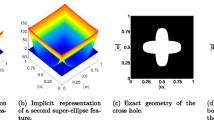Abstract
Two problems of optimum topological design of grillages are discussed: (1) the Equilibrium Linear Programming (ELP), where the analysis model is based only on equilibrium conditions and (2) the Nonlinear Program (NLP), where the ELP formulation is extended to include compatibility conditions. The structural topology is optimized by allowing elimination of elements. Three different force method formulations are presented for each of the problems. It is shown that the optimal topology for the NLP problem might correspond to a singular point in the design space. The optimal topology for the ELP problem is obtained by solving a linear program (LP).
Conditions for selecting a geometry of Multiple Optimal Topologies (MOT) are derived. The objective function for the MOT geometry is shown to be independent of the redundant forces, and some of the optimal topologies are usually statically determinate structures. In such cases the lower bound on the optimal value obtained by the ELP solution is equal to the final global optimum. Examples are given to illustrate how the optimal topology and its corresponding load path change with the geometric parameters. Design procedures that combine automated optimization and CAD techniques are most suitable for solving the presented problems.
Similar content being viewed by others
Abbreviations
- A :
-
vector defined by Eq. (12)
- a ik :
-
coefficients depending on the structural geometry
- B :
-
vector defined by Eq. (14)
- F :
-
flexibility matrix
- I :
-
number of design variables
- i :
-
subscript denoting design variables
- j :
-
subscript denoting cross sections
- K :
-
number of redundant forces
- k :
-
subscript denoting redundant forces
- L :
-
superscript denoting lower bound
- l, l x, ly :
-
lengths of elements
- M :
-
vector of internal moments
- M L :
-
vector of moments due to external loads
- M LA ,M LR :
-
subvectors ofM L
- M N :
-
vector defined by Eq. (22)
- M Q :
-
matrix of moments due to unit value of redundant forces
- M QA ,M QR :
-
submatrices ofM Q
- N :
-
vector of redundant forces
- P :
-
concentrated load
- T :
-
matrix of 0, 1 linking elements
- T R :
-
submatrix ofT
- U :
-
superscript denoting upper bound
- X :
-
vector of design variables
- Z :
-
objective function
- α:
-
coefficient defined by Eq. (39)
- χ:
-
vector of displacements corresponding to redundant forces due to external loads
References
Atrek, E. et al. (Eds.) (1984) New Directions in Optimum Structural Design. New York: Wiley
Kirsch, U. (1981) Optimum Structural Design-Concepts, Methods and Applications, New York: McGraw-Hill
Schmit, L.A. (1981) Structural synthesis—Its genesis and development. AIAA J. 19, 1249–1263
Vanderplaats, G.N. (1982) Structural optimization, past, present, and future. AIAA J., 20, 992–1000
Topping, B.H.V. (1983) Shape optimization of skeletal structures: A review. J Struct. Eng., ASCE 109, 1933–1951
Dobbs, M.W., Felton, L.P. (1969) Optimization of truss geometry. J. Struct. Div., ASCE 95, 2105–2118
Dorn, W.C., Gomory, R.E., Greenberg, H.J. (1964) Automatic design of optimal structures. J. Mech. 3, 25–52
Kirsch, U. (1982) Synthesis of structural geometry using approximation concepts. Comput. Struct. 15, 305–314
Reinschmidt, K.F., Russell, A.D. (1974) Applications of linear programming in structural layout and optimization. Comput. Struct. 4, 855–869
Somekh, E., Kirsch, U. (1979) Structural Design Using Interactive Optimization. In Proceedings of Seventh ASCE Conference on Electronic Computation, St. Louis, Mo.
Kavlie, D., Moe, J. (1969) Application of nonlinear programming to optimal grillage design. Int. J. Num. Meth. Eng. 1, 351–378
Moses, F., Onoda, S. (1969) Minimum weight design of structures with application to elastic grillages. Int. J. Num. Method. Eng. 1, 311–331
Reinschmidt, K.F., Norabhoompipat, T. (1975) Structural optimization by equilibrium linear programming. J. Struct. Div., ASCE 101, 921–938
Taye, S. (1985) Optimum Design of Grillages. M.S. thesis, Faculty of Civil Engineering, Technion, Haifa, Israel
Sved, G., Ginos, Z. (1968) Structural optimization under multiple loading. Int. J. Mech. Sci. 10, 803–805
Author information
Authors and Affiliations
Rights and permissions
About this article
Cite this article
Kirsch, U., Taye, S. On optimal topology of grillage structures. Engineering with Computers 1, 229–243 (1986). https://doi.org/10.1007/BF01200139
Issue Date:
DOI: https://doi.org/10.1007/BF01200139




